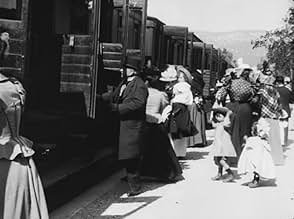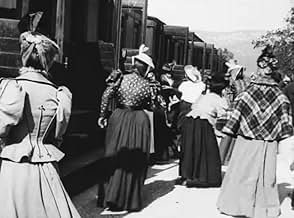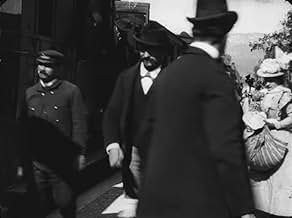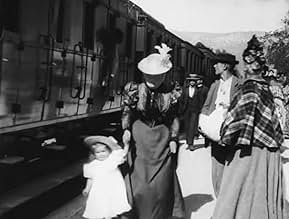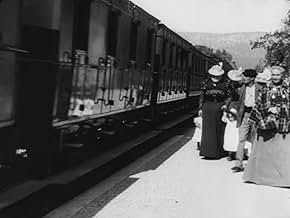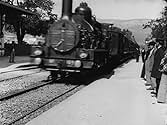La llegada de un tren a la estación de La Ciotat
Título original: L'arrivée d'un train à La Ciotat
PUNTUACIÓN EN IMDb
7,4/10
14 mil
TU PUNTUACIÓN
Un tren llega a la estación de La Ciotat.Un tren llega a la estación de La Ciotat.Un tren llega a la estación de La Ciotat.
- Dirección
- Reparto principal
Reseñas destacadas
The other reviewers are correct that this is a remarkable piece of history, but it is not the first movie. What film earns that honor depends partly on how you define movies. If you consider Edison's Kinetoscope shorts to be movies, the first movies were from 1893. And even before Edison, there had been some experimentation with projected motion pictures. Even if you give the Lumiere brothers credit for inventing the form (which is a very reasonable decision, but not an inevitable one), I believe their first film was "Workers Leaving The Factory" (aka " Sortie des usines Lumière, La (1895) ") Also, according to the "Oxford History of World Cinema", reports that terrified audience members hid under their seats when the film was first shown are probably apocryphal. Still, this (and the Lumiere brothers other early shorts) are well worth seeing for anyone who loves movies.
There doesn't seem to be anything particularly exciting about an approaching steam locomotive, but somehow this image has stuck, the first iconic scene in cinematic history. Produced by pioneering French filmmakers Auguste and Louis Lumière, 'L' Arrivée d'un train à La Ciotat / Arrival of a Train at La Ciotat' was filmed at La Ciotat, Bouches-du-Rhône, France on December 28, 1895 and first screened to a paying audience on January 6, 1896. The 50-second long film, like most other Lumière shorts, successfully captures a brief snippet of everyday life, chronicling the gradual approach of the train, its slow to a halt, and the disembarkment of its passengers.
For many years, there has been an enduring myth than, upon the first screening of the film, the audience was so overwhelmed by the image of the train bearing down upon them that they fled the room in terror. This has been shown to be something of an embellishment, and, though the film would undoubtedly have astounded and mesmerised audiences, there was never any real mass panic. French scientist Henri de Parville, who attended an early screening, is said to have written: "The animated photographs are small marvels. ...All is incredibly real. What a power of illusion! ...The streetcars, the carriages are moving towards the audience. A carriage was galloping in our direction. One of my neighbors was so much captivated that she sprung to her feet... and waited until the car disappeared before she sat down again." This, I think, adequately sums up how remarkable the film must have seemed back in 1896.
Auguste and Louis Lumière obviously recognised the power of illusion offered by their Cinématographe. In order to maximise the shock value of the approaching train, they have mounted the camera as close as possible to the edge of the platform, so that the audience feels as if they are almost standing right in the locomotive's path. The people departing from the train are just normal citizens going about their day (several Lumière relatives, however, can be spied on the platform), enhancing the realism of the short. Cinema does not get much more memorable than this.
For many years, there has been an enduring myth than, upon the first screening of the film, the audience was so overwhelmed by the image of the train bearing down upon them that they fled the room in terror. This has been shown to be something of an embellishment, and, though the film would undoubtedly have astounded and mesmerised audiences, there was never any real mass panic. French scientist Henri de Parville, who attended an early screening, is said to have written: "The animated photographs are small marvels. ...All is incredibly real. What a power of illusion! ...The streetcars, the carriages are moving towards the audience. A carriage was galloping in our direction. One of my neighbors was so much captivated that she sprung to her feet... and waited until the car disappeared before she sat down again." This, I think, adequately sums up how remarkable the film must have seemed back in 1896.
Auguste and Louis Lumière obviously recognised the power of illusion offered by their Cinématographe. In order to maximise the shock value of the approaching train, they have mounted the camera as close as possible to the edge of the platform, so that the audience feels as if they are almost standing right in the locomotive's path. The people departing from the train are just normal citizens going about their day (several Lumière relatives, however, can be spied on the platform), enhancing the realism of the short. Cinema does not get much more memorable than this.
Like the notorious inflation adjustment that gives Gone With the Wind (1939) the unbreakable box-office high, a slight technological adjustment given the time (109 years ago!) gives Arrival of a Train at La Ciotat (1895) the best special effects ever (relatively speaking, of course). Forget King Kong (1933), throw out Star Wars (1977), Arrival of a Train' blew audiences away with a little thing called moving pictures. There's a classic rumor of audiences running away from the movie screen, expecting the train to crash right through! As scary as Kong was, nobody expected him to reach into the audience and pick out a few snacks!
Also, it may not have been all that intentional, but the composition of this static, one-minute shot is excellent, and still unrivaled. The perspective of the train zooming past the lens like a wild stampede, the quick stop, then, the explosion of activity: people coming, going, on the train, off the train. What crisp energy! What a film! Viva la Lumiere!
Also, it may not have been all that intentional, but the composition of this static, one-minute shot is excellent, and still unrivaled. The perspective of the train zooming past the lens like a wild stampede, the quick stop, then, the explosion of activity: people coming, going, on the train, off the train. What crisp energy! What a film! Viva la Lumiere!
At just under a minute, L'Arrivée d'un train à La Ciotat (1895) is one of Louis Lumiere's earliest excursions into film-making. As was formulaic with what he called "actualités," or non-narrative shorts, Louis Lumiere set up his cinematographe (a portable crank-handled camera that triples as a film projector and developer) at such an accomplished angle as to catch the arrival of a train at La Ciotat, where it captures the bustling comers-and-goers of the station who happen to stray in front of the lens, looking altogether curious, or else wary of the unfamiliar contraption. The crowd seems lively enough, but just for good measure, Lumiere's refined wife and mother-in-law can be seen actively searching for an imaginary, but eagerly expected passenger.
As uninteresting as it is (and it IS, even for the most pretentious film buff), L'Arrivée d'un train à La Ciotat's historical appeal is undeniable, if not legendary. The film's effect upon its first public viewing is a well-worn myth told to enthusiastic film students by their professors. Apparently, initial audiences, unaware of film's capacity to fully imitate reality, fled in fear of the image of a train barreling down upon the screen. The French newspaper, Le courrier du centre, (July 14, 1896) alleged the advancing locomotive made "spectators draw back instinctively fearing they'd be run over by the steel monster." Nevertheless, such a widespread and instantaneous physical response seems foolish or naïve even then, especially when the projector would have been visible and the sound audible to all seated in what at that time passed as a "theater." In reality, it is far more likely that this incident was limited to a few isolated cases, and was later exaggerated to enhance its appeal and boost the film's reputation. Consequently, the commerciality of the venture succeeded with tremendous results. Over a hundred years later, not only is L'Arrivée d'un train à La Ciotat a cinematic icon, but proof of how powerful and impressionable moving pictures could (and would) become.
Recommended for those with an interest in film as an art form, or for those looking for early examples of film in history.
As uninteresting as it is (and it IS, even for the most pretentious film buff), L'Arrivée d'un train à La Ciotat's historical appeal is undeniable, if not legendary. The film's effect upon its first public viewing is a well-worn myth told to enthusiastic film students by their professors. Apparently, initial audiences, unaware of film's capacity to fully imitate reality, fled in fear of the image of a train barreling down upon the screen. The French newspaper, Le courrier du centre, (July 14, 1896) alleged the advancing locomotive made "spectators draw back instinctively fearing they'd be run over by the steel monster." Nevertheless, such a widespread and instantaneous physical response seems foolish or naïve even then, especially when the projector would have been visible and the sound audible to all seated in what at that time passed as a "theater." In reality, it is far more likely that this incident was limited to a few isolated cases, and was later exaggerated to enhance its appeal and boost the film's reputation. Consequently, the commerciality of the venture succeeded with tremendous results. Over a hundred years later, not only is L'Arrivée d'un train à La Ciotat a cinematic icon, but proof of how powerful and impressionable moving pictures could (and would) become.
Recommended for those with an interest in film as an art form, or for those looking for early examples of film in history.
I have little to add to other reviewers, except to say that this film took a sudden importance in my life last year. In 2002 I was travelling by train to my first ever Cannes Film Festival. At one point the train was moving slowly and I looked out of the window and found that we were pulling through La Ciotat, and the platform hadn't changed a bit. Sadly the train didn't stop, otherwise I would have been tempted to jump off for a moment, but given the purpose of my journey I felt a strange thrill at being there. Just a little personal anecdote, but perhaps it shows something of the power and importance of those early steps in film.
¿Sabías que...?
- CuriosidadesPopular legend has it that, when this film was shown, the audience fled in terror, fearing being run over by the "approaching" train. This legend has since been identified as promotional embellishment, though there is evidence to suggest that people were astounded at the capabilities of the Lumières' cinématographe.
- ConexionesEdited into Louis Lumière (1968)
Selecciones populares
Inicia sesión para calificar y añadir a tu lista para recibir recomendaciones personalizadas
Detalles
- Duración1 minuto
- Color
- Mezcla de sonido
- Relación de aspecto
- 1.31 : 1
Contribuir a esta página
Sugerir un cambio o añadir el contenido que falta

Principal laguna de datos
By what name was La llegada de un tren a la estación de La Ciotat (1896) officially released in India in English?
Responde
